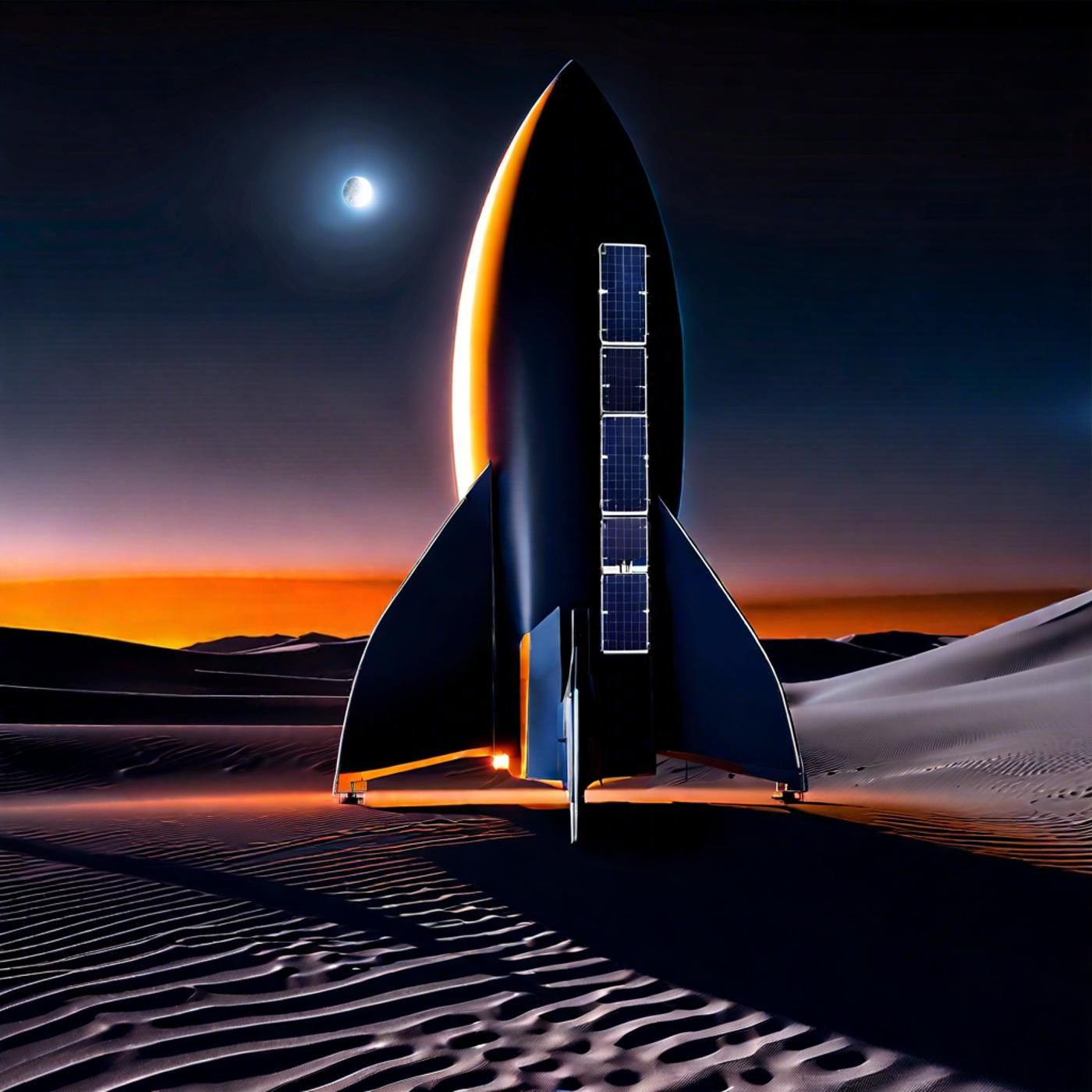S03E132: ESA's Lunar/Earth Maneuver, Mars' Frequent Impacts, and Doritos in Space
Welcome to another exciting episode of Astronomy Daily with your host, Anna. In today's episode, we've got a stellar lineup of fascinating space news straight from the cosmos. From a historic lunar flyby by the European Space Agency's JUICE mission to...
Welcome to another exciting episode of Astronomy Daily with your host, Anna. In today's episode, we've got a stellar lineup of fascinating space news straight from the cosmos. From a historic lunar flyby by the European Space Agency's JUICE mission to unexpected discoveries about Mars, courtesy of NASA's InSight lander. We've got it all. We'll also dive into the groundbreaking Polaris Dawn mission, which promises to feature the first-ever commercial spacewalk. And if that weren't enough, we'll wrap things up with a fun twist: zero gravity snacks from Doritos that are making their way into space. Buckle up, because this journey through the universe is going to be out of this world.
- **ESA's JUICE Mission: A Historic Lunar Flyby**: The European Space Agency's Jupiter Icy Moons Explorer (JUICE) is performing an unprecedented double gravity assist maneuver by swinging by both the Moon and Earth. This historic event aims to slingshot JUICE toward its ultimate destination, Jupiter and its intriguing moons Ganymede, Callisto, and Europa. The Moon's gravity served as a break, enabling JUICE to slow down in its trajectory relative to the Sun, effectively saving the spacecraft about six months of travel time. Photographs from the lunar encounter were taken using JUICE's onboard monitoring cameras, capturing remarkable images shared in real-time with the public via a live webcast.
- **Unexpected Discoveries on Mars**: NASA's Mars InSight lander, though no longer active, continues to provide invaluable data. A new study revealed that Mars gets bombarded by space rocks far more frequently than previously estimated. This insight comes from a combination of seismic data and orbital imagery, suggesting a pressing need to update our current models of Martian geological activity and surface evolution. Notably, two of the newly discovered craters are the largest ever detected on Mars, each roughly the size of a football field. This finding has far-reaching implications for our understanding of planetary surfaces across the solar system.
- **Polaris Dawn Mission: The First Commercial Spacewalk**: The Polaris Dawn mission team, led by billionaire entrepreneur Jared Isaacman, is ready to embark on a groundbreaking journey. This mission raises the stakes in commercial space exploration by aiming to perform the first-ever commercial spacewalk. The crew, including retired US Air Force pilot Scott "Kidd" Poteet and SpaceX engineers Anna Menon and Sarah Gillis, will attempt to break Earth orbit altitude records and conduct approximately 40 experiments. Additionally, the mission aims to pioneer high-speed internet access in space using Starlink connectivity.
- **Zero Gravity Snacks: Doritos in Space**: Doritos is launching a new limited edition flavor called Cool Ranch Zero Gravity, designed specifically for space travel. These specially formulated chips feature an oil-based coating to prevent crumbs from floating in microgravity environments. The Polaris Dawn mission will see its crew become the first people to eat Doritos in space. Doritos has partnered with the Polaris Dawn crew to raise awareness and funds for St. Jude Children's Research Hospital, contributing a $500,000 donation and offering fans the chance to win mission-themed memorabilia.
For more Astronomy Daily, including our continually updating newsfeed, visit our website at astronomydaily.io. Follow us on social media at AstroDailyPod on Facebook, X, YouTubeMusic, and TikTok. We love engaging with our community, so be sure to drop us a message or comment on your favorite platform.
For more Space and Astronomy News Podcasts, visit our HQ at www.bitesz.com.
Become a supporter of this podcast: h
Welcome listeners to another exciting episode of Astronomy Daily with your host, Anna. In todays episode, we've got a stellar lineup of fascinating space news straight from the cosmos. From a historic lunar flyby by the European Space Agency's JUICE mission to unexpected discoveries about Mars courtesy of NASA's InSight Lander, we've got it all. We'll also dive into the groundbreaking Polaris Dawn mission, which promises to feature the first-ever commercial spacewalk. And, if that weren't enough, we'll wrap things up with a fun twist—zero-gravity snacks from Doritos that are making their way into space! Buckle up, because this journey through the universe is going to be out of this world.
JUICE, the European Space Agency's Jupiter Icy Moons Explorer, is today performing an unprecedented double gravity-assist maneuver by swinging by both the moon and Earth. On Monday, August 19th, the probe came within just 465 miles of the lunar surface, utilizing this close encounter to capture some remarkable images, which were shared in real time with the public via a live webcast. The moon flyby is the first leg of a journey designed to slingshot JUICE toward its ultimate destination: Jupiter and its intriguing moons - Ganymede, Callisto, and Europa. These flybys are historic, as no mission has ever performed a double gravity assist like this. The moon's gravity served as a "brake," which enabled JUICE to slow down in its trajectory relative to the sun. This counterintuitive approach, leveraging lunar and Earth gravity, effectively saves the spacecraft about six months of travel time, allowing it to reach Jupiter by July 2031.
Photographs from Monday's lunar encounter were taken using JUICE's onboard monitoring cameras. While these images may not be as sharp as those taken by other high-resolution cameras, they serve essential functions like confirming the deployment of the probe's solar arrays and scientific instruments. The probe's mission is to explore three of Jupiter's moons, each believed to harbor oceans beneath their icy crusts. Europa, in particular, is of great interest because its ocean is likely in contact with a rocky seafloor, potentially fostering intriguing chemical reactions. The seas of Ganymede and Callisto might be sandwiched between layers of ice, presenting another different but equally compelling scenario for scientists. With its successful moon flyby, JUICE is now set for an Earth flyby today, which will bring the probe within 4,250 miles of our planet. This maneuver is designed to further refine its trajectory and set it on course for a final gravity assist from Venus in August 2025.
It's fascinating to think that amateur astronomers in the Pacific region might catch a glimpse of JUICE through their telescopes during this encounter, a fleeting yet magical moment connecting us to this immensely ambitious mission. This ingenuity in space travel exemplifies how collaborative efforts and groundbreaking engineering continue to push the boundaries of our understanding and exploration of the cosmos.
Let's dive into some groundbreaking discoveries on Mars, courtesy of NASA's Mars InSight Lander. Though the lander is no longer active, its legacy continues to provide invaluable data that have surprised scientists. A new study has revealed that Mars gets bombarded by space rocks far more frequently than previously estimated. This insight comes from a combination of seismic data and orbital imagery, suggesting a pressing need to update our current models of Martian geological activity and surface evolution. In this recent research, led by a team from Brown University, data from InSight’s highly sensitive onboard seismometer were analyzed to reveal eight new impact craters that had gone unnoticed from orbit. The finding is remarkable because it shows that the frequency of meteoroid impacts on Mars could be two to ten times higher than what we had previously thought. This has far-reaching implications not just for Mars but for our understanding of planetary surfaces across the solar system.
By comparing seismic signals with before-and-after orbital images, scientists could confirm the origins of these impacts. Notably, two of these craters are the largest ever detected by scientists on Mars, each roughly the size of a football field. What makes this even more astounding is that these massive impacts occurred just 97 days apart. Such a short interval between major impacts indicates that Mars might be pelted with significant space rocks much more frequently than anticipated. The implications of these findings extend beyond Mars. As researchers like Ingrid Daubar of Brown University suggest, we may need to rethink how we estimate the age and evolution of planetary surfaces throughout our solar system. If Mars is more geologically active due to these frequent impacts, it calls for a revision of existing cratering models, which could enrich our understanding of planetary histories and future exploration risks.
Additionally, this research aids in preparation for future missions. Knowing the true frequency of impacts can better assess potential hazards and design better protective measures for both robotic and human explorers. Even though the InSight mission ended in 2022, its seismic data is a treasure trove that continues to unveil new secrets about the Red Planet. Stay tuned, as more revelations from Mars’ seismic activities are undoubtedly still to come.
The Polaris Dawn mission team has touched down in Florida, ready to embark on what promises to be a groundbreaking journey. Led by billionaire entrepreneur Jared Isaacman, the mission raises the stakes in commercial space exploration by aiming to perform the very first commercial spacewalk. The crew, also including retired U.S. Air Force pilot Scott “Kidd” Poteet, and SpaceX engineers Anna Menon and Sarah Gillis, brings together an exceptional blend of expertise and ambition. Isaacman, reflecting on the mission’s preparation, noted, “It’s been two-and-a-half years since we announced the Polaris Program and Polaris Dawn. It’s been a really exciting journey of development and training.” The team's arrival in Florida is another significant milestone in this ambitious program. The mission itself is the first of three flights planned under the Polaris Program, with each aiming to push the boundaries further. Not only will Polaris Dawn attempt to break Earth-orbit altitude records by reaching a staggering 1,400 kilometers, but it will also conduct the first commercial spacewalk using SpaceX-designed extravehicular activity (EVA) suits. During this spacewalk, both Isaacman and Gillis will venture outside the Dragon spacecraft, attached solely by a safety tether.
The goals of Polaris Dawn span a range of scientific and technological advancements, all while contributing to SpaceX’s broad vision of making life multi-planetary. Over the course of their five days in orbit, the crew will carry out approximately 40 experiments from 20 different research institutions. Moreover, they will conduct a technology demonstration of Starlink internet connectivity aboard the Dragon spacecraft, aiming to pioneer high-speed internet access even in the harsh conditions of space. Another fascinating aspect of this mission is how it mirrors the Apollo-era experience by traversing regions like the Van Allen radiation belts. The mission promises to yield significant insights into human health and spacecraft performance in high-radiation environments. Bill Gerstenmaier, SpaceX’s vice president of Build and Flight Reliability, emphasized, “The high altitude will give us exposure to this high-radiation environment, which will test a lot of avionic systems and their ability to recover.”
Behind all the science and excitement, there’s a deeply philanthropic core to Polaris Dawn. The crew is also using this mission as a platform to support St. Jude Children’s Research Hospital, leveraging public excitement about space exploration to raise awareness and funds for childhood cancer research. Details on how you can contribute coming up in our next story. So, as Jared Isaacman and his team gear up for their August 26th launch, the world watches not just for the high-altitude records they might break or the innovative science they will conduct, but for the significant steps forward in humanity’s quest to become a multi-planetary species and the collaborative spirit of adventures that look to stir public good along the way.
And speaking of Polaris Dawn, Doritos is launching a new, limited-edition flavor called Cool Ranch Zero Gravity, designed specifically for space travel. The iconic chips, enjoyed on Earth for nearly 60 years, have traditionally been banned from outer space because their "dust" and crumbs pose risks to spacecraft systems. Now, thanks to food scientists at FritoLay, these concerns have been addressed. The new formulation features an oil-based coating that keeps the flavor intact while preventing crumbs from floating around in microgravity environments. Additionally, the chips have been miniaturized into bite-size pieces to further reduce any risks. These specially designed Doritos are set to make history as they blast off with the Polaris Dawn mission aboard a SpaceX Dragon spacecraft. The mission will see its crew become the first people to eat Doritos in space, while also setting new records in human spaceflight and conducting the first-ever commercial spacewalk.
But there's more to this mission than just satisfying a snack craving. Doritos has partnered with the Polaris Dawn crew to help raise awareness and funds for St. Jude Children's Research Hospital. Fans on Earth can donate to receive their own Cool Ranch Zero Gravity chips in special glow-in-the-dark canisters. Doritos is also contributing a hefty $500,000 donation to support St. Jude's efforts in combating childhood cancer. In a move to engage the public further, fans can also win mission-themed memorabilia, including patches, pins, apparel, and even space-flown Doritos tins. The initiative aims to raise $85,000 from these pledges, bringing together space enthusiasts and snack lovers for a good cause. Tina Mahal, senior vice president of marketing at PepsiCo Foods North America, said, "With every new Doritos innovation, we hope to encourage snackers to pave new paths. The Cool Ranch Zero Gravity chips embrace what it means to live life boldly by pioneering a creative way to raise awareness for such an important cause."
This intriguing blend of space exploration and consumer engagement not only adds a fun twist to the Polaris Dawn mission but also underscores the potential for space travel to inspire and unite people for important humanitarian causes. Who knew that a simple snack could contribute so much to scientific advancement and charitable efforts?
And that's it for today. Thank you for tuning into this episode of Astronomy Daily with me, Anna. I hope you enjoyed our dive into the latest cosmic events and discoveries. Don't forget to visit our website at astronomydaily.io for the freshest updates on space news including updates on the JUICE flyby, our free daily newsletter, and access to all our past episodes. Additionally, you can stay connected with us on social media—just search for AstroDailyPod on Facebook, X, YouTube, and TikTok. Until next time, keep looking up!
New to Astronomy Daily - The Podcast?
Here are some great episodes to start with.


















